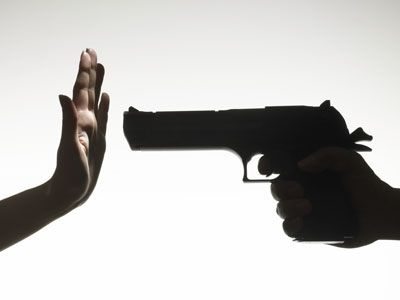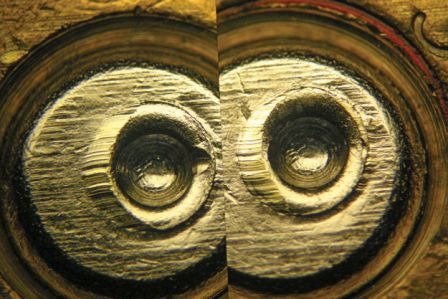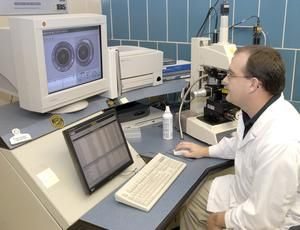IBIS: Integrated Ballistics Identification System
In prehistoric times, when crime-solving technology was basic, almost non-existent, evidence-matching was a daunting task. Remember those days? You know, way back in the early 2000’s… Well, bullet-to-firearm matches were especially tough in those oh-so-distant times. Investigators first recovered spent ammunition, the bullet or bullet fragments and/or the part of the round that once contained the powder (cartridge). Then they set out on the mission of trying to match those bullet parts to the weapon that fired them.
Markings on the surface of a fired bullet – Larry Reynolds photo
Two fired cartridges – Larry Reynolds photo
To do so, they examined the recovered evidence for specific markings left behind by the firearm—lands and grooves left by the pattern inside the gun barrel, and firing pin and ejector marks left on the cartridge.
Then, investigators set out on the mind-numbing task of manually searching scores of image databases and other evidence comparison collections, hoping to locate a match to their piece of evidence. And it sometimes took forever and a day to find a match, if then.
Well, in 2003 a new star in the evidence-matching world was born…IBIS. The Integrated Ballistics Identification System. IBIS is totally automated, much like the AFIS and CODIS systems (fingerprint and DNA systems). Once IBIS hit the scene, investigators were able to enter an image into the system, starting a search of images from all databases AND from all current, on-going, and past crime scenes. And all this is done automatically, without having to paw through page after page of pictures.
But, it’s still not like you see on TV. There’s no moment where an image of a bullet pops up on a computer screen next to a picture of a suspect, complete with the thug’s address, phone number, and shoe size.
Investigators still must compare the items by hand and eye to determine that the two images, the image of the evidence and the database image, are indeed a match.
background: #bd081c no-repeat scroll 3px 50% / 14px 14px; position: absolute; opacity: 1; z-index: 8675309; display: none; cursor: pointer; top: 188px; left: 20px;”>Save








Good work Lofland,
You are correct to point out that IBIS is a critical tool for police. In the U.S. alone it has helped police generate new leads in over 80,000 cases. It has been proven in various studies to help police solve more gun crimes. Is it perfect – no – do the marks on guns change over time? Yes However, the real question is do they change so much that identifications cannot be made? The truth is that matches between fired ammo components can be made with such frequency so as to consider the forensic science of firearms examination by humans assisted by machines a must have tool in the crime solving tool box.
When I worked at the gun shop, we got to answer lots and lots of questions from customers about why their newly minted gun came with a spent cartridge. Most assumed that it was to show that the gun did actually go bang.
I would assume, though, that with use, the markings would change. For instance, I have something like 10k rounds through my Para. Parts are starting to wear out (I’m not happy about that BTW) and I’ll have to start replacing them. If I was to replace my ejector, wouldn’t that completely change the markings on the cartridge, making IBIS useless? Or what about the wear on the barrel? The barrel’s in good shape and I won’t be replacing it soon, but you would think that eventually the lands and grooves would change.